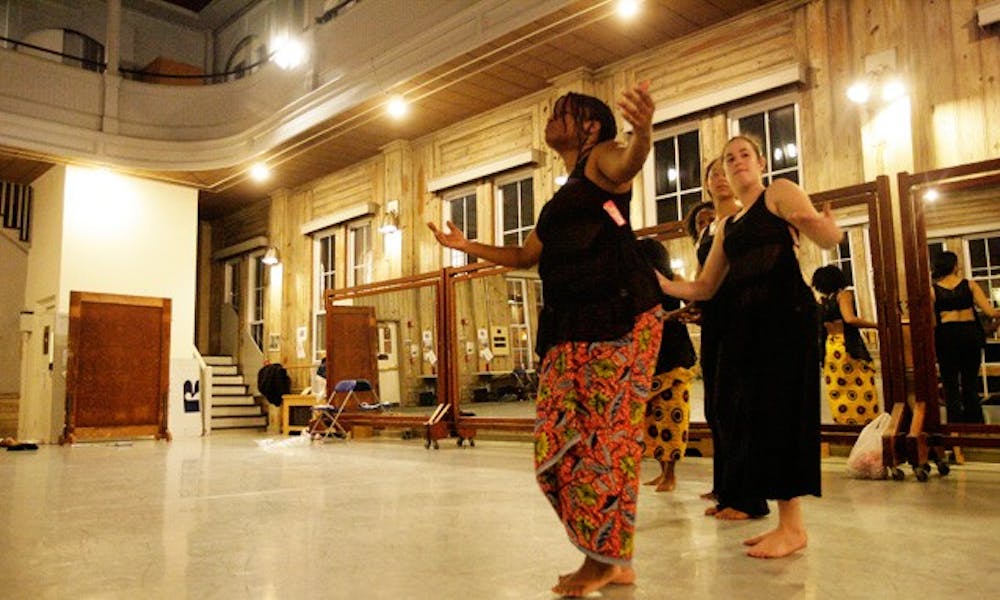The semester-long, combined efforts of roughly 50 to 60 staff members, faculty, guest artists and students will culminate in this weekend’s annual November Dances.
The event highlights six vastly different works by visiting faculty Amanda Miller, guest artist Sujata Mohapatra, Andrea Woods, assistant professors of the practice of dance, Ava LaVonne Vinesett and juniors Danika Manso-Brown and Monica Hogan.
“The thing that’s terrific about this year’s performance is that there’s something for everyone,” said Tyler Walters, associate professor of the practice of ballet and co-director of the Duke University Ballet Repertory Ensemble. “There’s high energy in the African dance, elegant and detailed work in the classical Indian dance, a beautiful solo and ballet—which has its own kind of elegance.”
A world-famous expert in classical Indian Odissi, Mohapatra will underscore the precision, rhythm and technical grace of this traditional genre through her dance, Walters said. Miller, who founded the Pretty Ugly Dance Company in Freiburg, Germany, will present a new piece this weekend, accompanied by the music of Bach.
In contrast, Woods’ dance features the local old-time string sound of the Carolina Chocolate Drops, and Vinesett’s work—deemed “fun and energetic” by Walters—stems from the African ritual dance of Kakilambe.
Additionally, Manso-Brown and Hogan were selected by the dance department to have their pieces shown alongside world-acclaimed artists and esteemed faculty members.
Manso-Brown’s solo work is entitled “Letters to Haiti,” inspired by the devastating earthquake earlier this year. She began choreographing the piece last semester after listening to classical music in a dance class.
“This piece came so organically,” she said. “It was something I felt so connected to. I knew I would submit it for November Dances.”
She added that representing such a large-scale and traumatic event in an authentic manner was challenging at times.
“When you’re working with a topic that is so serious, it is hard to make it feel especially real and not corny or over the top in any way,” she said. “I definitely had to take the time to find the right emotions, ones respectful enough to perform because the [earthquake] affected so many people. It would only be right for me to put in the energy to make this dance possible.”
“Letters to Haiti” begins with silence followed by spoken verb, which combines poetry and movement, in the first section, then closes with a second section featuring classical chamber music.
“I really loved that I got to use spoken verb in my piece,” Manso-Brown said. “I liked being able to express myself in multiple mediums.”
Hogan builds on Manso-Brown’s theme of strength during trying times while capitalizing on the versatility of an ensemble in “Common Thread.” Dancers include senior Sarah King, junior Anna Hevia, sophomores Catherine Bittar, Betsy Boxberger and Courtney Liu and freshman Zsofia Solta.
Hogan acknowledged that the work is particularly timely because it deals with the role of women in society—a hot topic on campus right now. Her piece will explore subjects such as acceptance, self-consciousness, self-worth and body image.
“I was thinking about all of the different ways women act in social situations and how the way we put ourselves forward changes how we interact with others and think about ourselves,” she explained.
The piece is divided into five sections reflecting five different situations for women: alone, in a co-ed group, in the corporate world, as an individual with others present and finally, in a group of only women.
To convey a sense of solidarity in the last section, Hogan assigned all her dancers the “homework” of creating a short character profile so they could better understand the individual nature of their persona, as well as their role within the larger context of women.
“Even though someone can feel like they are the only person going through a struggle, the people you encounter every day are going through a lot of the same things as you—and maybe don’t communicate it,” Hogan said.
November Dances will take place Nov. 20 at 8 p.m. and Nov. 21 at 3 p.m. in Reynolds Theater in the Bryan Center. Tickets are $15, $10 for Senior Citizens and $5 for students. Tickets are available at tickets.duke.edu.
Get The Chronicle straight to your inbox
Signup for our weekly newsletter. Cancel at any time.

